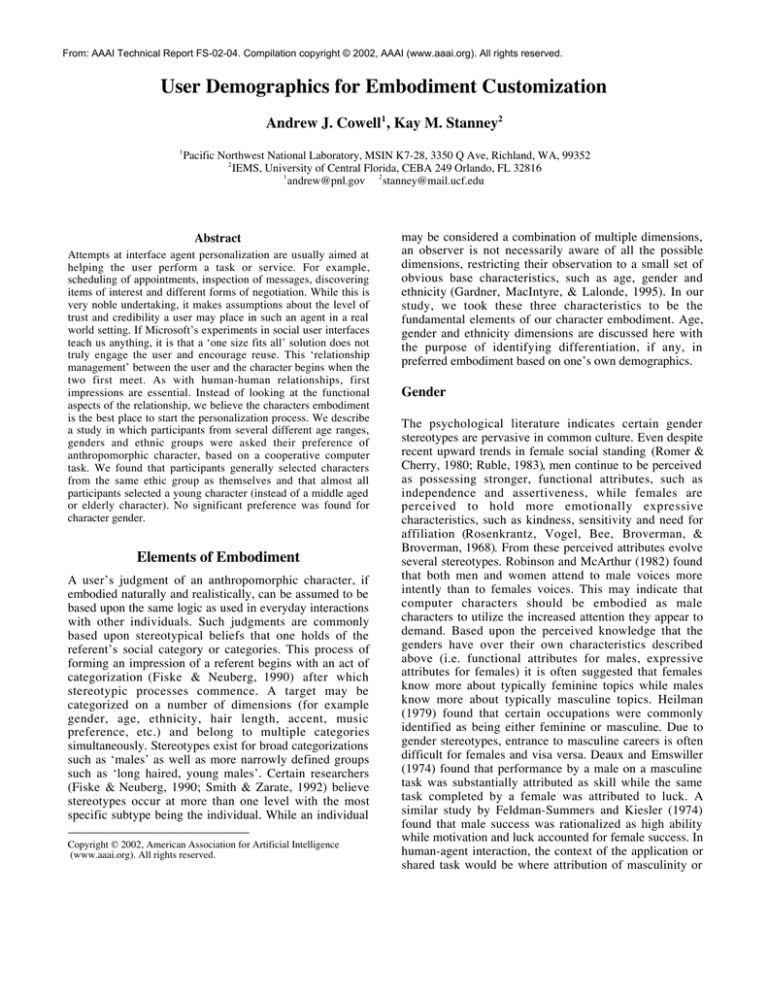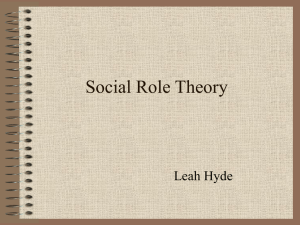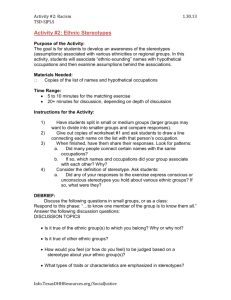
From: AAAI Technical Report FS-02-04. Compilation copyright © 2002, AAAI (www.aaai.org). All rights reserved.
User Demographics for Embodiment Customization
Andrew J. Cowell1 , Kay M. Stanney2
1
Pacific Northwest National Laboratory, MSIN K7-28, 3350 Q Ave, Richland, WA, 99352
2
IEMS, University of Central Florida, CEBA 249 Orlando, FL 32816
1
andrew@pnl.gov 2 stanney@mail.ucf.edu
Abstract
Attempts at interface agent personalization are usually aimed at
helping the user perform a task or service. For example,
scheduling of appointments, inspection of messages, discovering
items of interest and different forms of negotiation. While this is
very noble undertaking, it makes assumptions about the level of
trust and credibility a user may place in such an agent in a real
world setting. If Microsoft’s experiments in social user interfaces
teach us anything, it is that a ‘one size fits all’ solution does not
truly engage the user and encourage reuse. This ‘relationship
management’ between the user and the character begins when the
two first meet. As with human-human relationships, first
impressions are essential. Instead of looking at the functional
aspects of the relationship, we believe the characters embodiment
is the best place to start the personalization process. We describe
a study in which participants from several different age ranges,
genders and ethnic groups were asked their preference of
anthropomorphic character, based on a cooperative computer
task. We found that participants generally selected characters
from the same ethic group as themselves and that almost all
participants selected a young character (instead of a middle aged
or elderly character). No significant preference was found for
character gender.
Elements of Embodiment
A user’s judgment of an anthropomorphic character, if
embodied naturally and realistically, can be assumed to be
based upon the same logic as used in everyday interactions
with other individuals. Such judgments are commonly
based upon stereotypical beliefs that one holds of the
referent’s social category or categories. This process of
forming an impression of a referent begins with an act of
categorization (Fiske & Neuberg, 1990) after which
stereotypic processes commence. A target may be
categorized on a number of dimensions (for example
gender, age, ethnicity, hair length, accent, music
preference, etc.) and belong to multiple categories
simultaneously. Stereotypes exist for broad categorizations
such as ‘males’ as well as more narrowly defined groups
such as ‘long haired, young males’. Certain researchers
(Fiske & Neuberg, 1990; Smith & Zarate, 1992) believe
stereotypes occur at more than one level with the most
specific subtype being the individual. While an individual
Copyright © 2002, American Association for Artificial Intelligence
(www.aaai.org). All rights reserved.
may be considered a combination of multiple dimensions,
an observer is not necessarily aware of all the possible
dimensions, restricting their observation to a small set of
obvious base characteristics, such as age, gender and
ethnicity (Gardner, MacIntyre, & Lalonde, 1995). In our
study, we took these three characteristics to be the
fundamental elements of our character embodiment. Age,
gender and ethnicity dimensions are discussed here with
the purpose of identifying differentiation, if any, in
preferred embodiment based on one’s own demographics.
Gender
The psychological literature indicates certain gender
stereotypes are pervasive in common culture. Even despite
recent upward trends in female social standing (Romer &
Cherry, 1980; Ruble, 1983), men continue to be perceived
as possessing stronger, functional attributes, such as
independence and assertiveness, while females are
perceived to hold more emotionally expressive
characteristics, such as kindness, sensitivity and need for
affiliation (Rosenkrantz, Vogel, Bee, Broverman, &
Broverman, 1968). From these perceived attributes evolve
several stereotypes. Robinson and McArthur (1982) found
that both men and women attend to male voices more
intently than to females voices. This may indicate that
computer characters should be embodied as male
characters to utilize the increased attention they appear to
demand. Based upon the perceived knowledge that the
genders have over their own characteristics described
above (i.e. functional attributes for males, expressive
attributes for females) it is often suggested that females
know more about typically feminine topics while males
know more about typically masculine topics. Heilman
(1979) found that certain occupations were commonly
identified as being either feminine or masculine. Due to
gender stereotypes, entrance to masculine careers is often
difficult for females and visa versa. Deaux and Emswiller
(1974) found that performance by a male on a masculine
task was substantially attributed as skill while the same
task completed by a female was attributed to luck. A
similar study by Feldman-Summers and Kiesler (1974)
found that male success was rationalized as high ability
while motivation and luck accounted for female success. In
human-agent interaction, the context of the application or
shared task would be where attribution of masculinity or
femininity would lie. For example, if the shared task were
to determine faults with a car engine, the stereotypical
context would be of a masculine task, whereas if the shared
task were flower arrangement the stereotypical context
would be of a female task.
Dominant behavior is another area where gender
stereotypes exist. In females, dominance and
aggressiveness are regarded as undesirable, whereas they
are permissible and even encouraged in males (Costrich,
Feinstein, Kidder, Maracek, & Pascale, 1975; Deutsch &
Gilbert, 1976). Nass, Moon and Green (1997) describe
males placed in dominant roles as “assertive” and
“independent”, whereas females are seen as “pushy” or
“bossy” (p. 865). Such gender affects could cause
unfavorable evaluations regardless of the quality of an
agent’s work.
As part of the ‘Computers As Social Actors’ program at
Stanford University, Nass, Moon and Green (1997)
performed studies to determine whether computers
embedded with gender cues would generate gender-based
stereotypic responses. Their results indicated strong
support for the ‘male evaluation’ stereotype. Both male and
female participants rated a male-voiced computer more
positively than a female-voiced computer. Their work also
supported the ‘masculine/feminine’ stereotype, although
the results were less definite. Finally, they supported the
‘female dominance’ stereotype, showing that femalevoiced computers that interacted in a dominant fashion
were rated as significantly less friendly as compared to
their male-voiced counterparts.
At first glance, this work appears to suggest that an agent
should be embodied as a male character to ensure
successful interaction. A male character may be attended to
more intently, and may not be penalized if it acts in a
dominant manner. A male-embodied agent may suffer in
feminine contexts (i.e. users’ may question the agents’
expertise), although Nass, Moon and Green found a
relatively weak effect. Such a decision would coincide with
findings in a study by Mack et al (1979) that found that
virtually all males (98%) and a high percentage of females
(85%) attributed male characteristics to a standard
computer. Unfortunately, this research is inconclusive.
None of this previous research has been based specifically
on realistic anthropomorphic agents. It is possible that a
referent may make a different choice when presented with
an geometrically accurate embodiment, versus a computer
that speaks with a male or female voice (Nass, Moon &
Green, 1997) or a computer that makes no effort to
engender itself (Mack et al, 1979).
Ethnicity
Ethnicity is another demographic variable that is easily
discernable early in an interaction cycle. Ethnic stereotypes
are often depicted on television and new media where the
ethnic spectrum is not homogeneous, with Caucasian’s
appearing much more frequently than any other ethnic
group. While African Americans appear more frequently
then they once did, they are often depicted negatively, as
criminals or perpetrators of violent crime (Gerbner, Gross,
Morgan, & Signorielli, 1986). A similar stereotype was
found in a report from the University of Washington that
compared the probation reports of black and white
juveniles. Black individuals charged with the same crime,
of the same age and having the same criminal history as a
white individual would have their crimes described as
being caused by internal attributes or aspects of their
character (e.g. being disrespectful toward authority or
condoning criminal behavior) while the white juveniles’
crimes would be more likely blamed on negative
environmental factors (e.g. exposed to excessive family
conflict or association with other delinquents). A study by
Peffley et al (1997) found similar negative stereotypes in
the context of state welfare. Even though many individuals
would not admit to harboring such negative stereotypes,
they are common and affect the manner in which people
interact with individuals from another ethnic group. Such
ethnic stereotypes may be extended to computer characters
at the user interface.
While such literature suggests that an African American
embodiment for a computer character would be an unwise
choice, a growing section of literature suggest that African
Americans hold their own racial stereotypes. Often labeled
as ‘reverse racism’, a growing body of literature indicates
ethnic stereotypes are reciprocal (Jaroff, 1994; Fish, 1993;
Gross, 1977; Lynch, 1989; Horowitz, 2000).
Another ethnic group to consider are Asian Americans.
Generally, the ethnic stereotypes describing Asian
Americans are not as negative as those describing African
Americans although they can be just as damaging. Many
see Asian Americans as the model minority (Delener &
Barlow, 1990) and “academic nerds” (“Asian Americans:
The Drive To Excel”, 1984 p.12), symbolizing educational
achievement and economic success. Such stereotypes
misrepresent the majority of Asian Americans and lead to
racial envy and, in some cases, violence (Yip, 1997). In
technological circles, such academic achievement
stereotypes have been extended to portray Asian
Americans as computer gurus (Taylor & Stern, 1997).
Yet another ethnic group to consider are Hispanic (Latino)
Americans. A review by Jackson (1995) suggests that
perceptions of Hispanics are generally unfavorable.
Hispanics are often viewed as lazy, cruel, ignorant and
belligerent but also as family-oriented and tradition-loving
(Fairchild & Cozens, 1981). Similarly, a study by Marin
(1984) administered to Anglo Americans saw Hispanics as
aggressive, poor and lazy, but also family-oriented and
proud. Studies indicate that Hispanics use similar
stereotypes when describing themselves (Montenegro,
1971; Peterson & Ramierez, 1971) and Horowitz (2000)
suggests this may be true for all ethnic groups.
While it is not the intent of this study to perpetuate ethnic
stereotypes, it is prudent to acknowledge them and their
role in human-human communication. All ethnic groups
appear to harbor their own out-group prejudices. They also
use similar stereotypes for people of their own ethnic
group.
Age
While many studies in human-computer interaction (HCI)
look at how age affects the manner in which an individual
interacts with a computer system, few studies were found
that look specifically at how age affects interaction and
specifically how the age of a computer character affects
credibility. De Meuse (1987) indicates that a ‘similar to
me’ hypothesis exists and this was supported in certain
studies. Rosen and Jerdee (1976) found that young
managers saw older personnel as more resistant to change,
less creative, possessing a lower physical capability for
work and less suitable for retraining. Cleveland and Landy
(1981) reported that older workers were rated low on ‘self
development’ and ‘interpersonal skills’ by younger
workers. Contrary to this, a study by Schwab and Heneman
(1978) found that older employees rated older secretaries
lower in ability than younger ones. This suggests there
exists some age function that describes the preferred age of
an interacting partner. For preteen users, there appears to
be a ‘big brother’ mapping where the user prefers a
character that is ‘older and wiser’ (Johnson, 1995).
Teenage users and users up to their late twenties may feel
more comfortable interacting with a character of the same
age. If the character were any younger, the user may
question their domain knowledge, but if the character were
any older it may be consider too old fashioned and out of
date (Benford, 1998). Older users may prefer a younger
character. They may regard a computer character their own
age as knowing as little as they do about technology and
thus being of little help. As younger generations are usually
associated with being at ease with new technology, older
users may believe they make the best computer associates
(Benford, 1998). This collective research suggests that an
age function may exist that potentially directs users of all
ages to select a youthful computer character.
To empirically substantiate the hypotheses put forth in this
study, a set of experiments was conducted. An experiment
was performed to determine the preferred demographic
embodiment and the results of this were filtered into a
larger experiment that sought to determine the level of trust
and credibility a participant would confer on a character
based on differing levels of nonverbal behavior.
Empirical Study
The purpose of the pretest was to determine the preferred
agent embodiment for the computer character. Unlike the
behavioral mechanisms that agents may use when
interacting with users, physical embodiment cannot be
dynamically changed during an exchange. Hence a method
was required to determine the best design practices for the
selection of demographic variables considered in this
dissertation (gender, age and ethnicity of a computer
character). The hypotheses for this pretest were driven by
the inconclusive suggestions from the literature review.
Hypotheses
The following hypotheses are offered (alternative
hypotheses in braces):
a
H0/1 :A computer character that matches the ethnicity of
the user shall [not] be seen as a more preferable interaction
partner than a character that is not from the same ethnic
group.
b
H0/1 :A computer character embodied as a youthful
character will [not] be seen as a more preferable interaction
partner than a character that is embodied as one of the
other age presets (middle-aged/elderly).
c
H0/1 :A computer character embodied as a male character
will [not] be seen as a more preferable interaction partner
than a character that is embodied as a female character.
Method
The experimental task was a card sorting assignment.
Cards featuring characters describing all 18 permutations
of the three demographic variables, as shown in the table
below, were shown to pretest participants and they were
asked to sort them in order of which character they would
prefer to work with in a cooperative computer task.
Table 1 - Embodiment Characteristics
Age
Young
Middle Aged
Elderly
Gender
Female
Male
Ethnicity
African American
Asian American
Caucasian
An example character (a middle aged Caucasian female) is
shown in Figure 1. A Latino/Hispanic character was also
included initially, but withdrawn before testing began due
to difficulties in expressing significant differences between
this and the appearance of the Caucasian character. All
characters shared the same neutral hair, eye and clothes
colors to reduce preference selection to the elements we
were controlling.
results of this study, the final characters were matched to
the ethnicity of the participant, and a young character was
used throughout. The participants were asked to select
between a male and female character. Informal feedback
from the participants indicated that the characters’
embodiment was natural and genuine. Those who had
interacted with other types of interface agent expressed a
preference for our anthropomorphic, realistic
embodiments.
This study provides some potential design guidelines that
may help direct embodiment decisions for those interested
in using anthropomorphic computer characters in their
applications. The essence of the guidelines is that research
across sociology, psychology, social psychology and
political science provides good indicators of how an
individual’s demographic profile influences an
interactional dyad and further supports the premise that
there is transfer between human-human communication
and human-computer characters when embodied
realistically.
Acknowledgements
Figure 1 - A Middle Aged Caucasian Female Embodiment
Results
Forty-five college students from the University of Central
Florida participated in the experiment. These included
twenty males and twenty-five females. The group included
twenty Caucasians, nine Asians and sixteen African
Americans. The participants ranged in age from college to
middle aged. For each demographic element, the
participants preferred choice was compared to their own
demographic values and a match or no-match recorded. For
each variable, a test of proportions was used to determine
participant preference. Results indicated that a significant
(p = 0.05) majority of participants selected a character
matching their ethnicity and that was young (based on the
task being a cooperative computing endeavor). While most
participants selected a character that was opposite of their
gender, this difference was not significant. Based on these
results, the ethnicity of the character for the main
experiment was set to match that of the participant, the age
of the character was set to ‘young’ and the gender of the
character was left to participant choice.
Conclusion
The empirical study discussed in this paper was used as a
pre-test for a more in-depth study of the use of trusting
nonverbal behaviors by computer characters to encourage a
more credible interaction (Cowell, 2001). Based on the
This work was supported by a doctoral fellowship from
Eastman Kodak Research Labs. The authors would like to
thank the Human Factors department at EKRL for their
encouragement and guidance.
References
Benford, R. D. (1998). Social Issues. New York, NY:
Macmillan.
Billings, J. P. (1988). A Study of Nonverbal Behaviors of
School Principles and their Relationship to the Principles'
Ability to Develop Trust and Motivate Staff. Claremont
Graduate School, Claremont.
Cleveland, J. N., & Landy, F. J. (1981). The Influence of
Rater and Ratee Age on Two Performance Judgments.
Personnel Psychology, 34, 19-29.
Costrich, N., Feinstein, J., Kidder, L., Maracek, J., &
Pascale, L. (1975). When Stereotypes Hurt: Three Studies
of Penalties in Sex-role Reversals. Journal of Experimental
Social Psychology, 11, 520-530.
Cowell, A.J. (2001) Increasing the Credibility of
Anthropomorphic Computer Characters: The Effects of
Manipulating Nonverbal Interaction Style and
Demographic Embodiment. Ph.D. Dissertation, University
of Central Florida, Orlando, FL.
De Meuse, K. P. (1987). A Review of the Effects of
Nonverbal Cues on the Performance Apraisal Process.
Journal of Occupational Psychology, 60, 207-226.
Deaux, K., & Emswiller, T. (1974). Explanations of
Successful Performance on Sex-Linked Tasks: What is
Skill for the Male is Luck for the Female. Journal of
Personality and Social Psychology, 29, 80-85.
Delener, J. L., & Barlow, W. (1990). Informational
Sources and Media Usage: A Comparison Between Asian
and Hispanic Subcultures. Journal of Advertising Research,
30, 45-52.
DePaulo, B. M. (1992). Nonverbal Behavior and Self
Presentation. Psychological Bulletin, 111(2), 203-243.
Deutsch, C. J., & Gilbert, L. A. (1976). Sex-role
Stereotypes: Effect on Perceptions of Self and Others and
on Personal Adjustment. Journal of Counseling
Psychology, 23, 373-379.
Fairchild, H. H., & Cozens, J. A. (1981). Chicano,
Hispanic or Mexican American - What's in a Name.
Hispanic Journal of Behavioral Sciences, 3, 191-198.
Feldman-Summers, S., & Kiesler, S. B. (1974). Those Who
Are Number Two Try Harder: The Effect of Sex on
Attributions of Causality. Journal of Personality & Social
Psychology, 30(846-855).
Gardner, R. C., MacIntyre, P. D., & Lalonde, R. N. (1995).
The Effects of Multiple Social Categories on Stereotyping.
Canadian Journal of Behavioral Science, 27(4).
Gerbner, G., Gross, L., Morgan, M., & Signorielli, N.
(1986). Violence Profile No. 14: The Annenberg School of
Communications, University of Pennsylvania.
Heilman, M. E. (1979). High School Students'
Occupational Interest as a Function of Projected Sex Ratios
in Male-Dominated Occupations. Journal of Applied
Psychology, 64, 915-928.
Jackson, L. A. (1995). Stereotypes, Emotions, Behavior
and Overall Attitudes Towards Hispanics by Anglos
(Research Report #10). Michigan: Julian Samora Research
Institute, Michigan State University.
Johnson, A. G. (1995). The Blackwell Dictionary of
Sociology. Oxford, UK: Blackwell Publishers.
Mack, D., Williams, J. G., & Kremer, J. M. D. (1979).
Perception of a Simulated Other Player and Behavior in the
Reiterated Prisoner's Dilemma Game. The Psychological
Review, 29, 43-48.
Montenegro, M. (1971). Chicanos and Mexican
Americans: Ethnic Self-Identification and Attitudinal
Differences. San Francisco, CA: R & E Research
Associates.
Nass, C., Moon, Y., & Green, N. (1997). Are Machines
Gender Neutral? Gender-Stereotypic Responses to
Computers with Voices. Journal of Applied Social
Psychology, 27(10), 864-876.
Nass, C., Moon, Y., Morkes, J., Kim, E.Y., & Fogg, B. J.
(1997). Computers are Social Actors: A Review of Current
Research. In B. Friedman (Ed.), Moral and Ethical Issues
in Human-Computer Interaction. Stanford, C.A.: CSLI
Press.
Peterson, B., & Ramierez, M. (1971). Real, Ideal-Self
Disparity in Negro and Mexican-American Children.
Psychology, 8, 22-26.
Romer, N., & Cherry, D. (1980). Ethnic and Social Class
differences in Children's Sex-role Concepts. Sex Roles, 6,
246-263.
Rosen, B., & Jerdee, T. H. (1976). The Influence of Age
Stereotypes on Managerial Decisions. Journal of Applied
Psychology, 61, 428-432.
Rosenkrantz, P. S., Vogel, S. R., Bee, H., Broverman, I. K.,
& Broverman, D. M. (1968). Sex-role Stereotypes and Self
Concepts in College Students. Journal of Consulting and
Clinical Psychology, 32, 287-295.
Ruble, T. L. (1983). Sex Stereotypes. Sex Roles, 9, 397402.
Taylor, C. R., & Stern, B. B. (1997). Asian-Americans:
Television Advertising and the "Model Minority"
Stereotype. Journal of Advertising, 26(2), 47-61.
Tortoriello, T. R., Blatt, S. J., & DeWine, S. (1978).
Communication in the Organization - An Applied
Approach. New York, N.Y.: McGraw-Hill.
Wells, W. E., & Siegel, B. (1961). Stereotype Somatypes.
Psychological Review, 8, 78.
Yip, A. (1997, June 5-13). Remembering Vincent Chin.
Asian Week.




